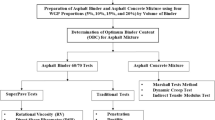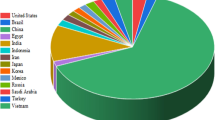Abstract
The hazardous environmental effects of greenhouse gas emissions and climate change demand alternative sources for cementitious materials in the construction industry. The development of geopolymer structures provides a way of producing 100% cement-free construction. In this research work, a novel and simple way of deriving nano particles from waste fly ash particles is promoted. The effect of adding the synthesized nano fly ash particles as a filler medium in geopolymer mortars was investigated by considering strength and durability properties. Parameter optimization was done by using regression analysis on the geopolymer mortar and the impact of adding nano fly ash particles was studied by varying different percentages of addition ranging from 0 to 7.5% by weight of binder content. From the results, it was observed that 1% nano fly ash acted not only as a filler but also as nano-sized precursors of the polymerization process, resulting in denser geopolymer medium. This can explain the extraordinary gain in strength of 72.11 MPa as well as the denser core with negligible level of chloride ion penetration, making the material suitable for the development of structures susceptible to marine environment.
Similar content being viewed by others
References
Davidovits J. Geopolymers: ceramic-like inorganic polymers. Journal of Ceramic Science and Technology, 2017, 8(3): 335–350
Ghazy M F, Abd Elaty M A, Taman M, Eissa M E. Durability performance of geopolymer ferrocement panels prepared by different alkaline activators. Structures, 2022, 38: 168–183
Ramezanianpour A A, Moeini M A. Mechanical and durability properties of alkali activated slag coating mortars containing nanosilica and silica fume. Construction and Building Materials, 2018, 163: 611–621
Lirer S, Liguori B, Capasso I, Flora A, Caputo D. Mechanical and chemical properties of composite materials made of dredged sediments in a fly-ash based geopolymer. Journal of Environmental Management, 2017, 191: 1–7
Carrajola R, Hawreen A, Flores-Colen I, de Brito J. Fresh properties of cement-based thermal renders with fly ash, air lime and lightweight aggregates. Journal of Building Engineering, 2021, 34: 101868
Zidi Z, Ltifi M, Ben Ayadi Z, El Mir L. Synthesis of nano-alumina and their effect on structure, mechanical and thermal properties of geopolymer. Journal of Asian Ceramic Societies, 2019, 7(4): 524–535
Siyal A A, Shamsuddin M R, Khan M I, Rabat N E, Zulfiqar M, Man Z, Siame J, Azizli K A. A review on geopolymers as emerging materials for the adsorption of heavy metals and dyes. Journal of Environmental Management, 2018, 224: 327–339
Reddy K R, Chetri J K, Kumar G, Grubb D G. Effect of basic oxygen furnace slag type on carbon dioxide sequestration from landfill gas emissions. Waste Management, 2019, 85: 425–436
Hounsi A D, Lecomte-Nana G, Djétéli G, Blanchart P, Alowanou D, Kpelou P, Napo K, Tchangbédji G, Praisler M. How does Na, K alkali metal concentration change the early age structural characteristic of kaolin-based geopolymers. Ceramics International, 2014, 40(7): 8953–8962
Hosan A, Haque S, Shaikh F. Compressive behaviour of sodium and potassium activators synthetized fly ash geopolymer at elevated temperatures: A comparative study. Journal of Building Engineering, 2016, 8: 123–130
Lo K W, Lin K L, Cheng T W, Chang Y M, Lan J Y. Effect of nano-SiO2 on the alkali-activated characteristics of spent catalyst metakaolin-based geopolymers. Construction and Building Materials, 2017, 143: 455–463
Hamdane H, Tamraoui Y, Mansouri S, Oumam M, Bouih A, Ghailassi T E, Boulif R, Manoun B, and Hannache H. Statistical modeling of geopolymers from dual-alkali activation of uncalcined phosphate sludge and their potential applications as sustainable coating materials. Journal of Cleaner Production, 2021, 283: 125421
John M. Fly ash classification—Old and New ideas. In: Proceedings of the World of Coal Ash (WOCA). Cleveland, 2017
Tippayasam C, Balyore P, Thavorniti P, Kamseu E, Leonelli C, Chindaprasirt P, Chaysuwan D. Potassium alkali concentration and heat treatment affected metakaolin-based geopolymer. Construction and Building Materials, 2016, 104: 293–297
Gupta N, Gupta A, Saxena K K, Shukla A, Goyal S K. Mechanical and durability properties of geopolymer concrete composite at varying superplasticizer dosage. Materials Today: Proceedings, 2021, 44: 12–16
Mohana R, Leela BSM. Sustainable utilization of pre-treated and nano fly ash powder for the development of durable geopolymer mortars. Advanced Powder Technology, 2022, 33(8): 103696
ASTM C109/C109M-2021. Standard Test Method for Compressive Strength of Hydraulic Cement Mortars. West Conshohocken, PA: ASTM International, 2021
ASTM C1202-2019. Standard Test Method for Electrical Indication of Concrete’s Ability to Resist Chloride Ion Penetration. West Conshohocken, PA: ASTM International, 2019
Adam A A, Horianto X X X. The effect of temperature and duration of curing on the strength of fly ash based geopolymer mortar. Procedia Engineering, 2014, 95: 410–414
Reddy M S, Dinakar P, Rao B H. A review of the influence of source Material’s oxide composition on the compressive strength of geopolymer concrete. Microporous and Mesoporous Materials, 2016, 234: 12–23
Mondal B, Maity D, Patra P K. Tensile characterisation of bamboo strips for potential use in reinforced concrete members: experimental and numerical study. Materials and Structures, 2020, 53(5): 128
Guo S, Qiao X, Zhao T, Wang Y S. Preparation of highly dispersed graphene and its effect on the mechanical properties and microstructures of geopolymer. Journal of Materials in Civil Engineering, 2020, 32(11): 04020327
Prasittisopin L, Sereewatthanawut I. Effects of seeding nucleation agent on geopolymerization process of fly-ash geopolymer. Frontiers of Structural and Civil Engineering, 2018, 12(1): 16–25
Liu B, Zhuang K, Li D, Fang Y, Pan G. Understanding the early reaction and structural evolution of alkali activated slag optimized using K-A-S-H nanoparticles with varying K2O/SiO2 aatios. Composites. Part B, Engineering, 2020, 200: 108311
Bakthavatchalam K, Rajendran M. An experimental investigation on potassium activator based geopolymer concrete incorporated with hybrid fibers. Materials Today: Proceedings, 2021, 46: 8494–8501
Andrade C, d’Andrea R, Rebolledo N. Chloride ion penetration in concrete: The reaction factor in the electrical resistivity model. Cement and Concrete Composites, 2014, 47: 41–46
Brant J A, Brunetta C D, Aitken J A. Chalcogenides and Nonoxides, Reference Module in Chemistry, Molecular Sciences and Chemical Engineering, Comprehensive Inorganic Chemistry II (Second Edition), From Elements to Applications. Netherlands: Elsevier, 2013, 213–283
Alouani M E, Alehyen S, Achouri M E, Hajjaji A, Ennawaoui C, Taibi M. Influence of the nature and rate of Alkaline activator on the physicochemical properties of fly ash-based geopolymers. Advances in Civil Engineering, 2020, 2020: 1–13
Adak D, Sarkar M, Mandal S. Effect of nano-silica on strength and durability of fly ash based geopolymer mortar. Construction and Building Materials, 2014, 70: 453–459
Khater H M, Abd el Gawaad H A. Characterization of alkali activated geopolymer mortar doped with MWCNT. Construction and Building Materials, 2016, 102(1): 329–337
Zahiri F, Eskandari-Naddaf H. Optimizing the compressive strength of concrete containing micro-silica, nano-silica, and polypropylene fibers using extreme vertices mixture design. Frontiers of Structural and Civil Engineering, 2019, 13(4): 821–830
Durak U, Karahan O, Uzal B, Ilkentapar S, Atis C D. Influence of nano SiO2 and nano CaCO3 particles on strength, workability, and microstructural properties of fly ash-based geopolymer. Structural Concrete, 2020, 22: 1–16
Sarkar M, Maiti M, Maiti S, Xu S, Li Q. ZnO-SiO2 nanohybrid decorated sustainable geopolymer retaining antibiodeterioration activity with improved durability. Materials Science and Engineering, 2018, 92(1): 663–672
Adak D, Sarkar M, Maiti M, Tamang A, Mandal S, Chattopadhyay B. Anti-microbial efficiency of nano silver-silica modified geopolymer mortar for eco-friendly green construction technology. RSC Advances, 2015, 5(79): 64037–64045
Pavithra P, Srinivasula Reddy M, Dinakar P, Hanumantha Rao B, Satpathy B K, Mohanty A N. A mix design procedure for geopolymer concrete with fly ash. Journal of Cleaner Production, 2016, 133: 117–125
Maiti M, Sarkar M, Maiti S, Malik M A, Xu S. Modification of geopolymer with size controlled TiO2 nanoparticle for enhanced durability and catalytic dye degradation under UV light. Journal of Cleaner Production, 2020, 255: 120183
Acknowledgements
The authors sincerely thank the Ministry of Environment, Forest and Climate change-Government of India and the management of Mepco Schlenk Engineering College, Sivakasi for the consistent support and encouragement to continue this project (Reg. no. 271/2018/RE) successfully.
Author information
Authors and Affiliations
Corresponding author
Ethics declarations
Competing interests The authors declare that they have no competing interests.
Rights and permissions
About this article
Cite this article
Mohana, R., Bharathi, S.M.L. Parametric investigation on the novel and cost-effective nano fly ash impregnated geopolymer system for sustainable construction. Front. Struct. Civ. Eng. (2024). https://doi.org/10.1007/s11709-024-1010-5
Received:
Accepted:
Published:
DOI: https://doi.org/10.1007/s11709-024-1010-5




